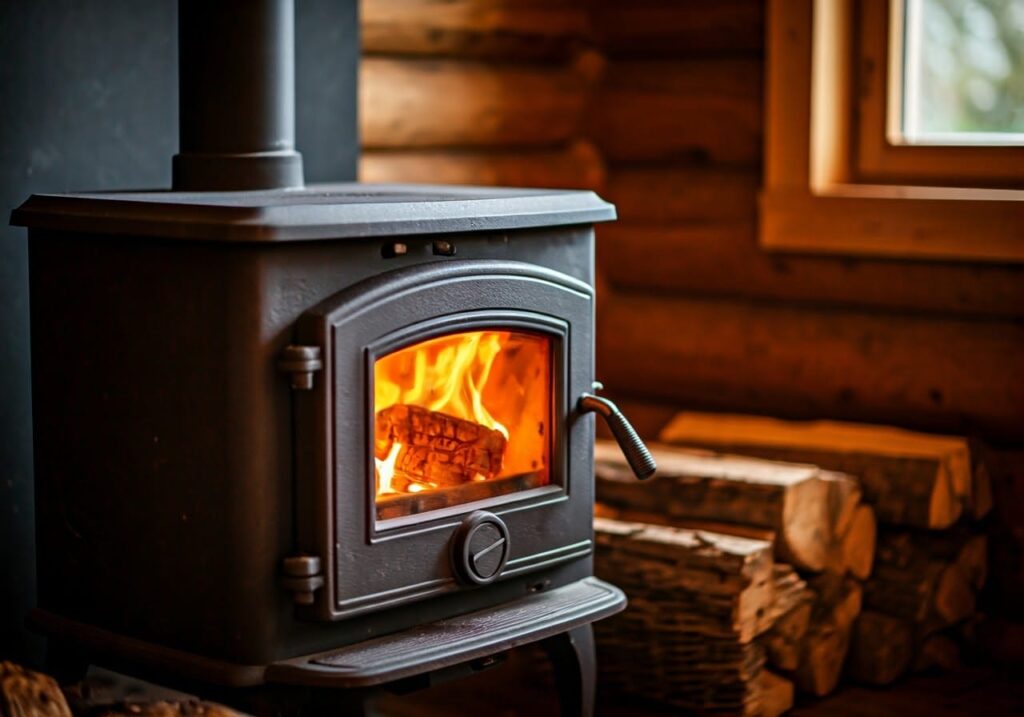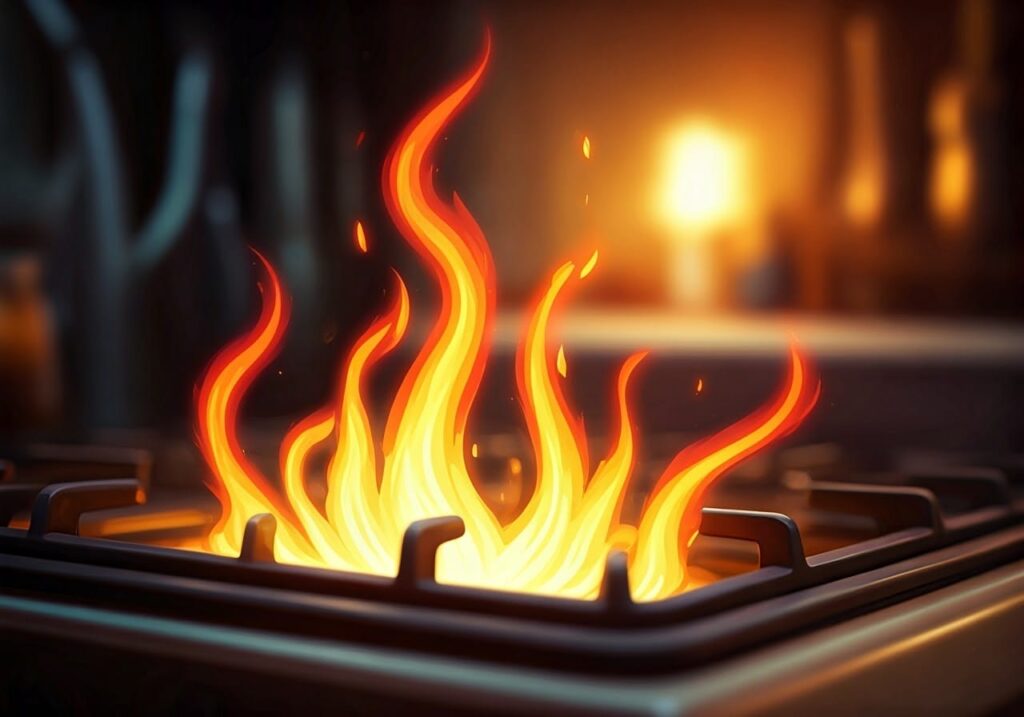Understanding air vent control is crucial for managing your wood stove’s heat output. While our complete guide to wood-burning stoves provides a comprehensive overview, this detailed exploration focuses specifically on the air control system and its impact on heat generation.

Understanding Air Control Systems: The Key to Efficient Combustion
Effective combustion in heating systems relies heavily on the precise management of air. This delicate balance is maintained by two crucial components: Primary Air Control and Secondary Air Systems. In this overview, we’ll delve into the functions and benefits of each, highlighting their roles in optimizing combustion efficiency and reducing environmental impact.
1. Laying the Foundation: Primary Air Control
The Ignition Point: Where Efficiency Begins
A robust combustion process starts with a strong foundation, and that’s exactly what Primary Air Control provides.
- Strategic Placement: Located below or in front of the firebox, this system is poised for maximum impact.
- Key Functions:
- Flame Intensity Regulation: Directly influences the main flame’s vigor, ensuring a consistent burn.
- Initial Burn Rate Optimization: Affects how efficiently fuel is consumed at startup, setting the tone for ongoing efficiency.
- Seamless Start-up Operations: Reliable ignition is guaranteed, every time.
- Outcome: Precise Primary Heat Output Control, allowing for tailored warmth and enhanced energy efficiency.
2. Elevating Efficiency: Secondary Air Systems
The Efficiency Multiplier: Taking Combustion to the Next Level
For those seeking to maximize their system’s potential, Secondary Air Systems offer a significant leap forward in technology.
- Innovative Design: Positioned above the fire, these systems capture and utilize residual energy that would otherwise be wasted.
- Benefits of Adoption:
- Enhanced Combustion Efficiency: Energy extraction from fuel is maximized, reducing waste.
- Sustainability Through Reduced Emissions: A cleaner burn minimizes environmental footprint.
- Complete Fuel Consumption: The secondary burn process ensures more thorough energy extraction.
- Result: A significantly more efficient, environmentally friendly heating solution.
Air Wash System
Glass cleaning mechanism:
- Directs air down glass
- Prevents smoke deposits
- Maintains visibility
- Improves aesthetics
- Indicates burn quality
Mastering the Art of Air Vent Management: Unlocking Efficient Heating
1. The Ventilation Backbone: Understanding Air Vent Principles
Optimizing Airflow Starts Here: The Crucial Role of Air Vents
Air vents are the unsung heroes of heating systems, playing a pivotal role in ensuring efficient airflow. Delve into the fundamental principles governing these essential components:
- Vent Design and Placement: Strategic Positioning for Maximum Airflow, influencing the entire system’s efficiency.
- Flow Control Mechanisms within Vents: Precision Regulation of Air, balancing intake and exhaust for optimal combustion.
- Damper Operations in Vents: The Fine-Tuned Valve, controlling airflow with precision to prevent heat loss.
- Pressure Dynamics through Vents: Harnessing Natural Forces, utilizing pressure differences to facilitate smooth airflow.
- Temperature’s Impact on Vent Performance: Adapting to Heat-Induced Air Behavior, for consistent efficiency.
2. Air Vents in Action: Tracing the Airflow Path
The Vent-Centric Journey: From Intake to Warmth
Now, let’s follow the airflow as it navigates through the vents, highlighting their integral role in the heating process:
- Intake Vents: The Fresh Air Gateway, drawing in oxygen for a robust combustion process.
- Circulation Vents: Efficient Heat Distribution Hubs, dispersing warmth evenly throughout the space.
- Exhaust Vents: The Safe Exit Strategy, reliably removing combustion byproducts via carefully managed draft creation.
- Vent-Driven Draft Creation: The Upward Motion Catalyst, ensuring seamless exhaust gas removal.
- Optimized Heat Distribution via Vents: The Ultimate Comfort Outcome, achieved through expertly managed airflow.
Temperature Control Through Air Management
Starting a Fire
Initial control settings:
- Full air opening
- Kindling arrangement
- Draft establishment
- Temperature building
- Transition timing
Maintaining Steady Heat
Regular operation:
- Finding optimal settings
- Adjusting for fuel load
- Reading temperature indicators
- Managing burn rate
- Responding to conditions
Controlling Burn Rate
Heat output management:
- Reducing air for longer burns
- Increasing for more heat
- Night-time settings
- Maximum efficiency points
- Safety considerations
Advanced Air Control Techniques
Fine-Tuning Performance
Optimization strategies:
- Weather adaptation
- Fuel type adjustments
- Load size considerations
- Draft management
- Temperature goals
Seasonal Adjustments
Adapting to conditions:
- Summer vs. winter settings
- Humidity effects
- Wind impact
- Temperature differences
- Draft variations
Common Air Control Problems
Insufficient Draft
Troubleshooting poor airflow:
- Chimney issues
- Blocked air intakes
- Weather effects
- Installation problems
- Maintenance needs
Excessive Air
Managing too much air:
- Over-firing risk
- Fuel waste
- Heat loss
- Control adjustment
- Safety concerns
Safety Considerations
Preventing Over-Firing
Temperature management:
- Warning signs
- Control responses
- Prevention techniques
- Emergency procedures
- Recovery methods
Carbon Monoxide Prevention
Safety measures:
- Proper ventilation
- Air supply maintenance
- Warning signs
- Detection systems
- Emergency procedures
Maintenance of Air Controls
Regular Checks
Maintenance routines:
- Control mechanism cleaning
- Obstruction removal
- Moving part lubrication
- Gasket inspection
- Operation testing
Common Repairs
Fixing air control issues:
- Stuck mechanisms
- Worn components
- Gasket replacement
- Adjustment needs
- Professional service
Understanding Draft
Natural Draft
How it works:
- Temperature differences
- Pressure variations
- Height effects
- Weather impact
- Seasonal changes
Draft Control
Managing airflow:
- Damper use
- Air intake adjustment
- Weather adaptation
- Temperature monitoring
- Performance optimization
Advanced Features
Automatic Controls
Modern innovations:
- Thermostat systems
- Smart controllers
- Temperature sensors
- Automated adjustments
- Safety features
Supplementary Systems
Additional control options:
- External air kits
- Draft enhancers
- Blower systems
- Heat distribution
- Control automation
Efficiency Optimization
Maximum Heat Output
Getting the most heat:
- Optimal settings
- Fuel selection
- Loading techniques
- Air control timing
- Temperature monitoring
Fuel Conservation
Extending burn times:
- Minimal air settings
- Proper wood selection
- Load optimization
- Draft control
- Efficiency monitoring
Troubleshooting Guide
Common Issues
Solving air control problems:
- Smoke spillage
- Poor heat output
- Difficult starting
- Uneven burning
- Control malfunction
When to Seek Help
Professional assistance needs:
- Major malfunctions
- Safety concerns
- Performance issues
- Installation problems
- Regular maintenance
Conclusion
Mastering air vent control is key to efficient wood stove operation. For more comprehensive information about wood stove operation and maintenance, refer to our complete guide on wood-burning stoves.


